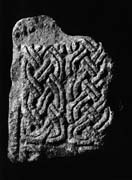Select a site alphabetically from the choices shown in the box below. Alternatively, browse sculptural examples using the Forward/Back buttons.
Chapters for this volume, along with copies of original in-text images, are available here.
Object type: Part of cross-shaft [1]
Measurements: H. 39.3 cm (15.5 in); W. 29.5 > 28.5 cm (11.6 > 11.25 in); D. 17.2 cm (6.75 in)
Stone type: See no. 3
Plate numbers in printed volume: 837-840
Corpus volume reference: Vol 3 p. 217-218
(There may be more views or larger images available for this item. Click on the thumbnail image to view.)
A (broad): The wide, flat edge moulding survives only on the left-hand side. Within the panel are two adjacent vertical runs of four-strand plain plait, using broad, median-incised strands. At the base are the terminals of another interlace or pair of interlaces.
B (narrow): Badly damaged; perhaps the moulding was cabled.
C (broad): The flat edge moulding survives only on the right-hand side. Within the panel are remains of two adjacent vertical runs of four-strand plain plait, using broad, median-incised strands, identical with that on face A. A terminal of the right-hand interlace is visible at the top.
D (narrow): The edge mouldings are flat and contain a panel of interlace in stringy, modelled strand. At the top it is standard four-strand plain plait, but the crossing points are avoided in the centre to form two adjacent two-strand twists before rejoining.
The double runs of adjacent interlace are a Stonegrave feature, and occur only rarely in Yorkshire: at Aberford, for example, in the West Riding (Collingwood 1915, fig. h on 130). This shaft shows that modelled strands and median-incised varieties could coexist. The hiatus on face D demonstrates an understanding of principles of interlace design and is adventurous when compared with the simple patterns of most Anglo-Scandinavian designs in Yorkshire.



